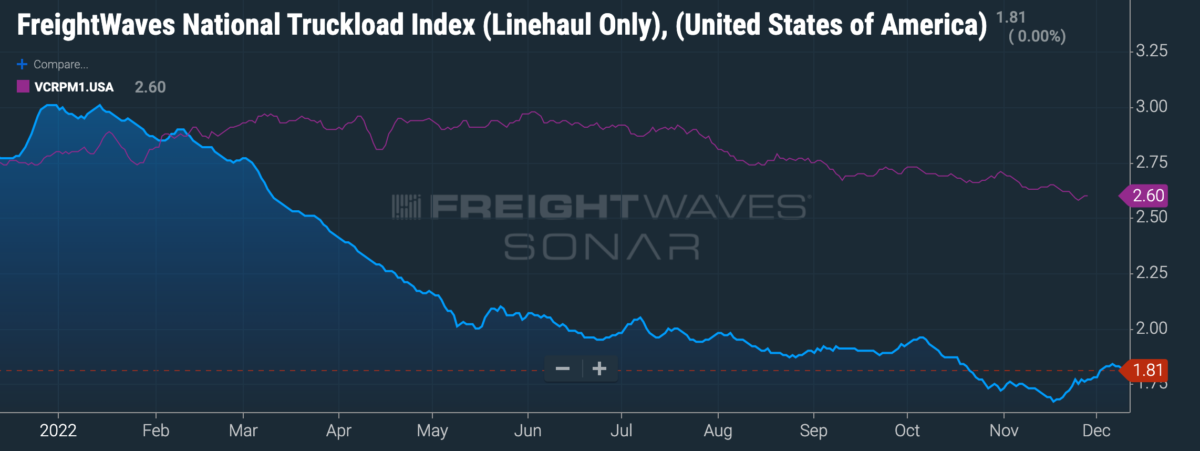There wasn’t much to smile about in 2020 as uncertainty gripped supply chains, but the spot market had owner-operators grinning. For many months, the going was good. Spot rates soared above contract rates, giving smaller fleets the chance to maximize profitability on every trip.
But the tide has swiftly turned.

Spot and contract rates, neck and neck for the past two years, have trended apart. The tango finally ended in late February, as FreightWaves SONAR shows that spot rates plunged and have yet to bounce back to the levels at which contract rates continue going for.
Jay Gustafson, executive vice president of brokerage operations at Echo Global Logistics, noted that national pricing indexes are showing spot pricing is currently more than 50 cents per mile less than contracted freight.
Finding it harder to turn a profit from the daily spot freight chase, owner-operators are turning to more stable, consistent capacity options. And many have found just that with Echo.
“As a third-party logistics provider that moves substantial volume, Echo offers both a transactional solution for the trucking companies in our network and lanes that move on a consistent schedule to create more stability,” Gustafson said.
Unlike other 3PLs that have transactional relationships with owner-operators, Echo caters to their varying needs through its contractual sourcing and continuous movement programs. The company’s contractual sourcing program provides carriers and owner-operators with consistent freight opportunities, targeting freight from its shipper network’s highest frequency lanes.
“Echo reaches out to carriers in a targeted manner to share with them the lanes that we’re looking to fill with consistent capacity,” Gustafson said. “That allows our owner-operator network to identify lanes that they’re interested in, then provide us a price that they can honor between typically six to 12 months.”
Each agreement is then honored at the set rate, by which freight will begin to be tendered to the owner-operator on a regular basis. This provides drivers with newfound pricing and lane stability and eliminates their need to make dozens of phone calls daily to find the next load.
“Most large shippers don’t work with owner-operators in that capacity, let alone work with owner-operators at all,” Gustafson said. “And most 3PLs don’t have the lane density to really create these static bid events. Our relationships and technology that we use to facilitate these bids allows Echo to offer freight to trucking companies in a way that’s different from most other 3PLs we compete with.”
Owner-operators are also finding the company’s strategic solutions to be quite beneficial with its continuous movement program, which allows carriers to dedicate a group of drivers to Echo at a guaranteed revenue threshold on a weekly basis, taking part in what Gustafson describes as a virtual dedicated fleet that Echo operates.
Although intended for larger enterprise fleets in the beginning, Echo’s continuous movement has garnered interest from a growing number of smaller fleets and owner-operators. Carriers of all sizes that no longer want to play ball with multiple brokers weekly are just looking for a single-source relationship for freight procurement.
Gustafson explained that owner-operators can expect to receive guaranteed mileage and payments every week. What’s more, those who drive over the threshold will be paid the amount on top of the revenue minimum. This level of customization even allows drivers to plan their schedules according to their preferred time at home.
“This continuous movement program creates for Echo a quasi-dedicated fleet where these drivers help support our shipper partners but also provide a great deal of stability for the drivers that commit to operating in this manner,” Gustafson said.
“I think many would anticipate the next six months to 12 months to look more like the last three than the market we saw throughout the pandemic,” he added, suggesting that if the spot market maintains its downward course, owner-operators can expect to see even lower rates per mile on every spot load to which they commit.
That is why Gustafson urges owner-operators to not just consider the short-term gains of the spot market, especially in its current state. He maintains planning for bad times is just as important as seizing the day when the going is good.
“Having stability and peace of mind, known volume on a weekly basis, allows you to build in some concrete expectations from a financial standpoint that lets you focus on areas other than chasing freight on a daily basis,” Gustafson said.
Click for more FreightWaves content by Jack Glenn.
More from Echo:
Carriers seeking stronger ties with reps while embracing digital future











